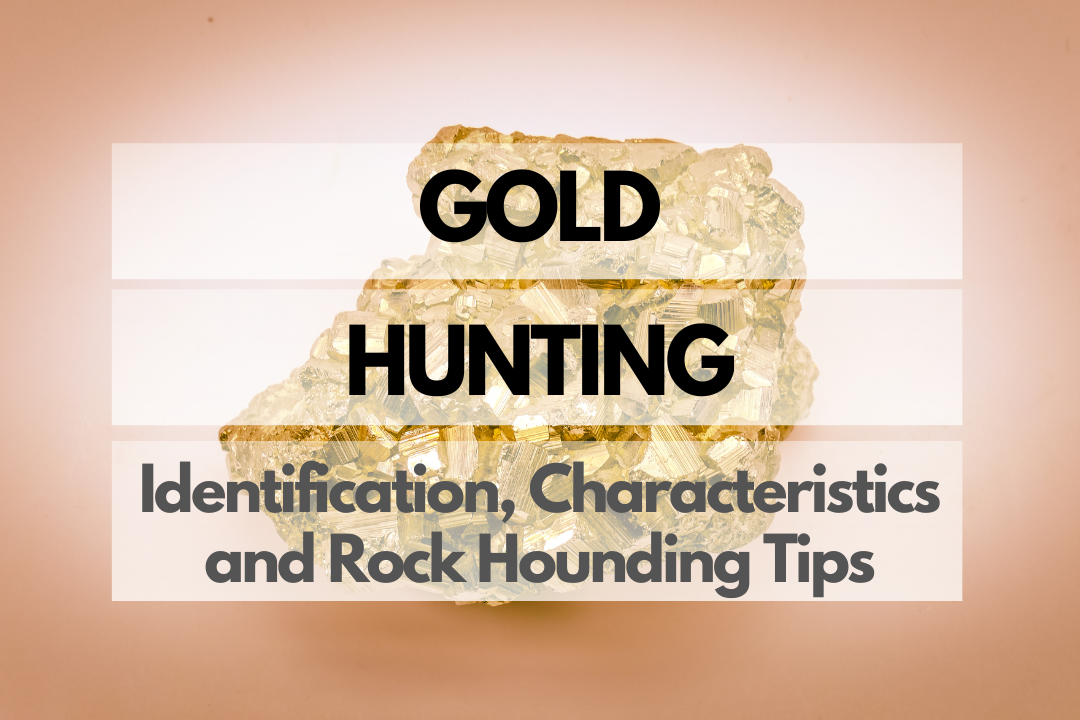Gold hunting has captivated the minds and hearts of people throughout history, sparking gold rushes, inspiring legends, and driving countless adventurers to seek their fortunes. In this article, we’ll delve into the fascinating world of gold, exploring its history, identification, characteristics, and various uses, as well as providing valuable tips for gold hunters and rock hounds alike.
History & Origin of Gold
Gold has been prized by humans for thousands of years, dating back to ancient civilizations such as the Egyptians, Mesopotamians, and Incas. The allure of gold has inspired countless tales of exploration and conquest, from the myth of King Midas to the California Gold Rush of the 19th century. The name “gold” comes from the Old English word “geolu,” which means “yellow,” reflecting the metal’s characteristic color. Throughout history, gold has held significant cultural, religious, and economic importance, often symbolizing wealth, power, and divine favor.
Gold Identification & Physical Properties
Identifying gold can be a thrilling experience, but it’s important to know what to look for. The table below provides an overview of the key physical properties of gold to help you recognize this precious metal in the field:
| Property | Description |
|---|---|
| Color | Yellow, ranging from bright yellow to a duller, almost brownish hue |
| Hardness | 2.5-3 on the Mohs scale |
| Luster | Metallic, often with a bright, shiny appearance |
| Streak | Gold, leaving a yellow streak on an unglazed porcelain tile |
| Specific Gravity | High, at around 19.3, making it one of the heaviest metals |
Gold Colors
Gold is most commonly recognized by its characteristic yellow color, which can range from a bright, almost reddish-yellow to a duller, brownish hue. The color of gold can be affected by impurities and alloying with other metals, resulting in various shades and hues. For example, white gold is created by alloying gold with metals like palladium or nickel, while rose gold is a result of alloying gold with copper.
Gold Hardness
Gold is a relatively soft metal, with a hardness of 2.5-3 on the Mohs scale. This makes it easy to work with for jewelry making and other applications, but also means it can be easily scratched or damaged. Gold’s softness is one of the factors that can help distinguish it from other minerals and metals that may look similar in appearance.
Gold Types
There are several types of gold that can be found in nature, each with its own unique characteristics:
Native Gold
Native gold is the most common type of gold found in nature. It is pure gold that has not combined with other elements and is typically found in veins, nuggets, or flakes. Native gold often forms in quartz veins, where it can be found alongside other minerals such as pyrite and quartz.
Electrum
Electrum is a naturally occurring alloy of gold and silver, with trace amounts of other metals such as copper. It is typically paler in color than pure gold, with a greenish or grayish tint. Electrum was highly prized in ancient times and was often used to mint coins.
Calaverite
Calaverite is a rare gold telluride mineral that contains gold in combination with the element tellurium. It is often found in association with other telluride minerals and can be a valuable source of gold. Calaverite is typically silvery-gray or brass-yellow in color and has a metallic luster.
Gold Uses
Gold has a wide range of uses, both practical and decorative. Some of the most common uses for gold include:
- Jewelry: Gold is a popular choice for jewelry due to its beauty, softness, and resistance to tarnish.
- Electronics: Gold is an excellent conductor of electricityand is often used in electronic components, such as connectors and switches.
- Investment: Gold has long been considered a stable investment, with many people buying gold bars, coins, or stocks as a hedge against inflation or economic uncertainty.
- Dentistry: Gold’s biocompatibility and malleability make it an ideal material for dental fillings, crowns, and other dental applications.
- Aerospace: Gold’s resistance to corrosion and excellent heat-reflecting properties make it valuable in the aerospace industry, where it is often used in satellite components and protective coatings.
How Much Is Gold Worth?
The value of gold can fluctuate depending on factors such as market conditions, purity, and weight. As of September 2021, the price of gold was around $1,750 to $1,800 per ounce, but it’s important to remember that prices can change over time. When considering the value of gold, it’s essential to take into account the purity (measured in karats, with 24-karat gold being the purest form) and the weight of the gold in question.
Gold Rock Hounding Tips
Ready to embark on your own gold hunting adventure? Here are some tips and tricks to help you have a successful and enjoyable gold rock hounding experience:
Essential Tools and Equipment
Equipping yourself with the right tools and equipment can make all the difference in your gold hunting endeavors. Some essential items you’ll want to have on hand include:
- Gold pan: A simple, inexpensive tool for separating gold from other materials.
- Metal detector: A specialized gold metal detector can help you locate gold nuggets and flakes more easily.
- Shovel or trowel: Useful for digging and moving soil or gravel while searching for gold.
- Tweezers or snuffer bottle: Helpful for picking up small gold flakes or nuggets.
- Rock hammer and chisel: Necessary for breaking open rocks that may contain gold.
- Backpack or bucket: For carrying your tools and any gold you find.
Safety Tips
Gold hunting can be a fun and rewarding hobby, but it’s essential to prioritize safety during your adventures. Keep the following safety tips in mind:
- Always let someone know where you’re going and when you plan to return.
- Carry a first-aid kit, plenty of water, and snacks in case of emergency.
- Wear appropriate clothing, including sturdy footwear and sun protection.
- Be aware of your surroundings and watch out for hazards like poisonous plants, insects, or unstable terrain.
- Respect private property and always ask for permission before entering or prospecting on someone else’s land.
Gold Hunting: Where to Find Gold
Gold can be found in various locations around the world, often near geological features such as quartz veins or ancient riverbeds. The table below highlights some of the best places to find gold, along with their specific locations:
| Site/Area | Location |
|---|---|
| Witwatersrand Basin | Gauteng, South Africa |
| Super Pit Gold Mine | Kalgoorlie, Western Australia |
| Carlin Trend | Nevada, United States |
| Yanacocha Gold Mine | Cajamarca, Peru |
| Grasberg Mine | Papua, Indonesia |
Caring For Your Gold
Properly caring for your gold can help preserve its beauty and value. Follow these tips to keep your gold in top condition:
- Store gold in a cool, dry place away from direct sunlight.
- Use a soft, lint-free cloth to gently clean gold without scratching its surface.
- Avoid exposing gold to harsh chemicals, which can cause discoloration or damage.
- Keep gold jewelry separate from other metals to prevent scratching or tarnishing.
Additional Resources
For more information and support in your gold hunting journey, consider exploring the following resources:
- Government resources: Bureau of Land Management Recreational Gold Prospecting
- Scientific articles: USGS Professional Paper 1674: The Gold System of Super Pit Gold Mine
- Forums: TreasureNet Gold Prospecting Forum
- Books: “Gold Panning and Placering in Colorado–How and Where” by Ben H. Parker Jr.
Additional Gold FAQs
Here are some frequently asked questions about gold that we haven’t covered yet:
What are the benefits of gold?
Gold has numerous benefits, including its use in jewelry, investment, and technology. Its properties make it highly valued for its beauty, resistance to tarnish, and malleability. Additionally, gold has been used in electronics, dentistry, and even aerospace applications due to its excellent conductivity and resistance to corrosion.
Do gold have any healing properties?
While many people believe in the healing properties of gold, it’s important to note that there is no scientific evidence to support these claims. However, gold has been used in traditional medicine and cultural practices for centuries, with some attributing anti-inflammatory, pain-relieving, and mood-enhancing properties to the precious metal.
Do gold have any spiritual meaning?
Gold has been associated with various spiritual meanings across different cultures and religions. In many belief systems, gold is considered a symbol of wealth, prosperity, and spiritual enlightenment. It has also been used in religious artifacts and ceremonies, as well as to adorn sacred spaces.
Do I need a permit to go gold hunting?
In the United States, you may need a permit for gold hunting depending on where you plan to search. Public lands managed by the Bureau of Land Management (BLM) often allow recreational gold prospecting, but specific rules and regulations vary by location. To find out if you need a permit and how to obtain one, visit the BLM’s Recreational Gold Prospecting page.
Closing Thoughts
Gold rock hounding can be an exciting and rewarding hobby, allowing you to explore the great outdoors, learn about geology, and potentially uncover valuable treasures. By equipping yourself with the right tools, following safety guidelines, and knowing where to look, you’ll be well-prepared for a successful gold hunting adventure. So grab your gear, and get ready to embark on a thrilling journey into the world of gold!

